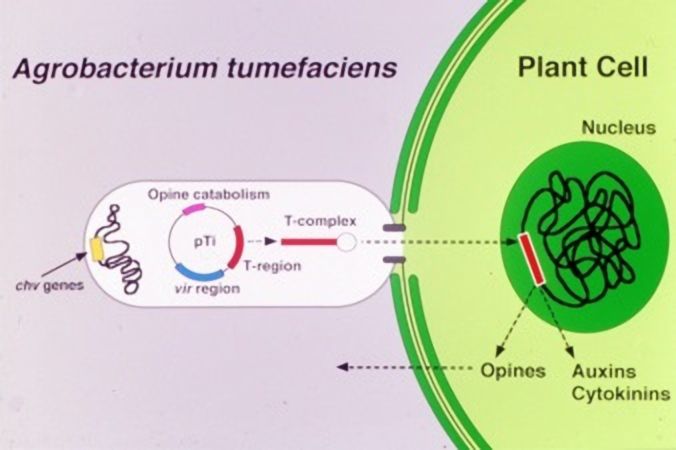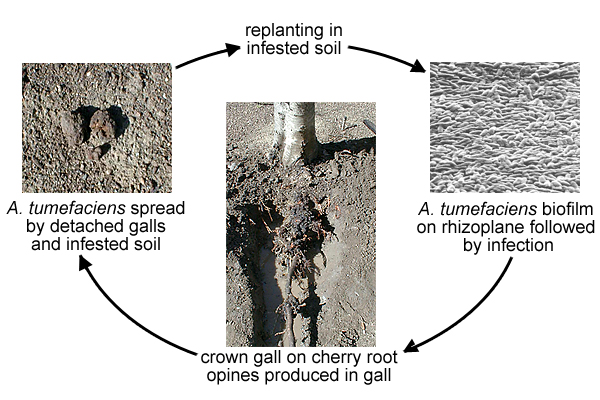Crown gall is a cancerous disease of many dicotyledonous plants that is caused by five main groups of soil and plant-inhabiting, ubiquitous, pathogenic agrobacteria: Agrobacterium tumefaciens (biovar1), Rhizobium rhizogenes (formerly A. radiobacter and A. rhizogenes)(biovar2), A. vitis (biovar3), R. rubi (formerly A. rubi) and A. larrymoorei.

Rose infected with crown gall disease ( Courtesy of Melodie Putnam Oregon State University, Plant Clinic)
These bacteria are present in most agricultural soils and pathogenic forms can cause a tumour (gall) disease that affect plants in nurseries, landscapes, vineyards, orchards and gardens worldwide. Infections occur in plant wounds from damage caused by propagation methods such as taking cuttings, grafting, budding, seed germination and other procedures such as transplanting, cultivation, and pruning. Other wounds caused by insects, animals, wind, freezing, frost conditions and within plant lenticels can also serve as sites for infection. If pathogenic agrobacteria come into contact with these fresh wounds, they can attach to and infect damaged plant cells within hours of exposure.

Diagram of infection process A.tumefaciens transformation of plant cell ( Courtesy Professor PJJ Hooykaas Leiden University The Netherlands)
Pathogenic agrobacteria are attracted to chemicals leaking from plant wound sites (e.g. phenolic plant metabolites such as acetosyringone and ∝-hydroxyacetosyringone and sugars), then colonise and firmly attach to injured plant cells. The presence of these plant compounds can activate transfer of part of their tumour-inducing plasmid (T-DNA) directly into the chromosomal DNA of the host plant cells. The T-DNA, once functional inside the plant cells, code for production of plant hormones (e.g. indoleacetic acid and cytokinins) and carbon-nitrogen compounds called opines (e.g. nopaline, octopine and agrocinopines A-D). Opines become food for the resident agrobacteria that colonise around the gall tissue. Agrobacterium is the only known organism capable of interkingdom DNA transfer.

Diagram A.tumefaciens biofilm spread crown gall ( Courtesy C Kado U.C. Davis CA )
Galls are typically located on the crown of the plant at or below the soil surface but can also be found on other plant parts. Fruit trees infected with crown gall produce lower yields with variable fruit set, size and quality. In severe conditions crown gall can weaken or kill the host plant. Losses to the nursery industry can be particularly severe because plants with crown gall must be culled.

